~ From a Bicameral to a Tricameral Consciousness ~
(The Study of Threes)
http://threesology.org

| IHV's page a | IHV's page b | IHV's page c | IHV's page d |
| IHV's page e | IHV's page f | IHV's page g | |
| Age of Insanity 1 (circa 2020) |
Age of Insanity 2 (circa 2020) |
||
Visitors as of 14 Jan 2020
The view of Ernst Haeckel was that the development of the individual organism (ontogeny) is a representation of the development of the group (phylogeny) to which the individual belongs. Sometimes referred to as the biogenetic law (1882) described as a theory of development in which an organism passes through successive stages resembling the series of ancestral types from which it has descended. Typically, it is abbreviated with the 3-patterned expression: Ontogeny recapitulates Phylogeny.
In providing evidence for such a view, the following examples of embryonic development of different animals has been shown:Drawings used by Ernst Haeckel as supporting evidence for his Biogenetic Law:
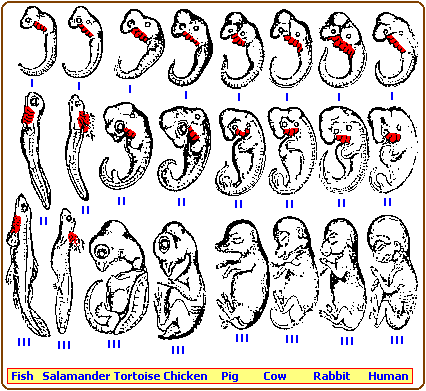
The illustration above is a generalized portrayal of the picture used by Ernst Haeckel in his 1866 General Morphologie der Organismen and his more famous 1874 Anthropogenie. The red areas are intended to indicate a similarity of early gill slit formation in the early stages of embryonic development of several different species. However, the illustration used by Haeckel has been called a fraud because it is said to contain false information regarding the actual structures. In other words, Ernst Haeckel is said to have deliberately altered some of the images in order to support his view that ontogeny provides indications of phylogeny, which in simpler terms means that our bodies have a similar developmental design that is exhibited in various body parts during different stages of development.
However, it was not until the 20th century that the Biogenetic law was modified by some observers to the effect that it represents embryonic development and not necessarily all later stages. In other words, his idea that "Ontogeny recapitulates Phylogeny" is said to be more accurate if it is described as "Embryonic Ontogeny recapitulates Embryogenetic Phylogeny."
By interpreting the development of the brain with the same formulaic concept as the biogenetic law, the following excerpt promotes an interesting consideration with respect to the ideas of Julian Jaynes:
C. Chiron, I. Jambaque, R. Nabbout, R. Lounes, A. Syrota, O. Dulac
Brain 1997, 120, 1057-1065
(Summary)
The development of functional brain asymmetry during childhood is confirmed by changes in cerebral blood flow measured at rest using dynamic single photon emission computed tomography. Between 1 and 3 years of age, the blood flow shows a right hemispheric predominance, mainly due to the activity in the posterior associative area. Asymmetry shifts to the left after 3 years. The subsequent time course of changes appear to follow the emergence of functions localized initially on the right, but later on the left hemisphere (i.e. Visuospatial and later language abilities). These findings support the hypothesis that, in man, the right hemisphere develops its functions earlier than the left.
Such a view as this inclines us to consider the possibility that early (adult) humans may have had a dominant functioning right hemisphere, and that the attributes of the left hemisphere did not or were not functioning in the manner in which they do today. This notion not only provides support to the idea of a Bicameral-like right hemisphere dominant mentality proposed by the theory of Julian Jaynes, with respect to early humans a few thousand years ago, but that present day humans may experience a similar type of functioning in one or more periods of their life.
Yet, was this type of mental predominance a characteristic of all humans in the past or merely those subjected to a certain type of genetic strain, culture, environment, dietary regime, etc?When Julian Jaynes was describing the Bicameral Mind, with an emphasis on making a distinction between right and left hemisphere functioning, he was not aware that upon looking closely at the attributes of the brain, we can discern a two- and three-patterned difference. Such a distinction is not commonly known nor presently taught in mainstream education classes, though it should be because of the implications of a broad application to many considerations:
When we look at the assigned culturally recognized attributes of the brain, we can see a distinct (over-lapping) 1-patterned, or 2-patterned, or 3-patterned arrangement:
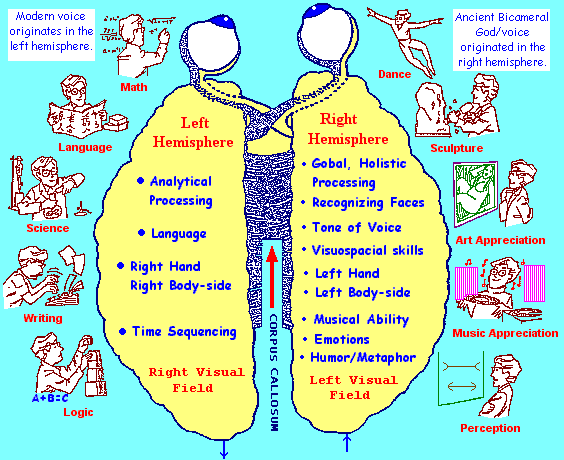
***Note: Much of the brain illustration shown above was adapted from page 106 of Dean Falk's book entitled "Brain Dance," 1992.
| Left
Hemisphere (Predominantly 3-patterned) Math: Associative Commutative Distributive Logic: Major Premise Minor Premise Conclusion Time Sequencing: Seconds~ Minutes~ Hours Past~ Present~ Future Day~ Week~ Month Language: Subject Object Verb |
Right
Hemisphere (Predominantly 2-patterned) Holistic: Macro versus Micro Whole versus Part Inner versus Outer Music: Major Scale vs Minor Scale Loud versus Soft (Quiet) Consonance vs Dissonance Visuospatial: (Art) Background vs Foreground Light vs Dark (Contrasts) 1 Dimension vs 2 Dimensions Emotions: Pain versus Pleasure Positive vs Negative Love versus Hate |
| Right Body Side: (Left Hemisphere) Tri-cuspid heart valve Three-lobed lung |
Left Body Side: (Right Hemisphere) Bi-cuspid heart valve Two-lobed lung |
 The correlations of two and three being made on this page are not (present day) typical considerations. However, I did come across a single reference concerning the tricuspid valve: | |
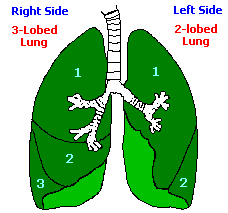 In recognizing that the left lung is smaller than the right lung (which provides room for the heart), let us conjecture that this is due to some past earlier developmental sequence just as we find the 1-layer, 2-layer, 3-layer sequential development of the 3 primordial germ layers (Ectoderm- Mesoderm- Endoderm) in primitive to more complex organisms. Hence, difference in size (dimorphism) as well as a two/ or three prominence may provide another link towards understanding developmental processes. Does this mean that the recurring smallness of the female to the male in many species indicates that females came before the male in terms of species-specific evolutionary development during particular environmental circumstances? If so, will there be an increased development towards a 3 to 1 "fusion" ratio? | |
|
(Reptilian/Limbic System) (Predominantly 1-Patterned) (Self)-Preservation~ (Self)-Procreation~ (Self)-Preeminence | |
It can clearly be seen that the (Reptilian) brain is focused on singularity (one- in terms of a "self" centeredness), the Right hemisphere is focused on duality (two), and the left hemisphere is focused on patterns-of-three. It is of interest to note that when we use the left hemisphere attribute "analysis" to define qualities of the right hemisphere, we often-times assign an additional third criteria in one form or another to the two-patterned references. When we use the right hemisphere attribute "viewing" (recognizing) to define qualities of the left hemisphere, we often-times alter the 3-part descriptions into 2-part "portraits." For example, and generally speaking:
Left Hemisphere "analyzing"
Right Hemisphere:
Holistic may acquire the additional
term "Synergy" or "Unity";
Music can develop a Triadic
structure;
Art acquires a 3rd dimension and 3-color
(trichromatic) theory;
Emotion is assigned words (in a 3-word
fashion) such as Compassion, Patience, and Empathy.
Right Hemisphere "viewing"
Left Hemisphere:
Math may be seen as Give &
Take;
Logic may become a Mind/Body dichotomy (that philosophers argue
about for centuries);
Time is related to Life &
Death;
Language is perceived as High & Low pitch.
Left Hemisphere "analyzing"
Reptilian characteristics:
Left Hemisphere attributes may
develop three criteria which distinguish a (3 in 1) singular nature, such as
arousal, motivation, and impulse.
Right Hemisphere "viewing"
Reptilian characteristics:
Right Hemisphere attributes may
picture the basic drives as the seat of emotion whereby a type of kinship
alliance is formulated in order to maintain the idea of a dual brain by not
permitting the "Reptilian Brain" a separate entity status.
It is not yet certain to what extent (if any) a reptilian brain is aware of those (left/right) brain attributes which exceed its own capacities. In other words, how much of an advanced brain can a primitive brain know? To use a simple analogy, how much can the brain of a human know the brain of a god? In the present instance, the development of the right and left hemisphere characteristics far exceed those of the reptilian, even though some would argue that any degree of overlapping nullifies the usage of an analogy that suggests one is god-like and the other is extremely primitive.
| Left Hemisphere (Predominantly 3-patterned) |
Right Hemisphere (Predominantly 2-patterned) |
||
 |
Sine- Cosine- Tangent A2 + B2 = C2 Associative- Commutative- Distributive |
 |
fast versus slow light versus heavy limp versus rigid |
 |
All languages are said to contain: Subject- Object- Verb |
 |
flat versus round in versus out depth versus height |
 |
Protons- Neutrons- Electrons Triplet codon DNA Igneous- Metamorphic- Sedimentary |
 |
1 dimensions vs 2 dimensions |
 |
. ? ! He- She- It Title- Body- Conclusion |
 |
Major Cord versus Minor Cord |
 |
Major Premise- Minor Premise- Conclusion Thesis- Antithesis- Synthesis Indulgence- "Middle Way"- Ascetism |
 |
long versus short up versus down in versus out |
 |
Time
Sequencing: Seconds ~ Minutes ~ Hours Past ~ Present ~ Future Day ~ Week ~ Month |
Whole vs Part | (Holism) |
By examining the attributes of the left and right hemispheres while at the same time acknowledging that the right hemisphere is the origin of the Bicameral mind, the 3 versus 2 developmental distinction appears to have been prophetically anticipated by Jesus, though it is not certain whether or not he had an appreciation of the larger context of the Bicameral "2" relation and a Tricameral "3" emergence that is occurring in a multitude of areas, and appears to be an underlying formula that can distinguish many of the conflicts occurring today. However, most people focus on the representative familial titles such as Father/Mother, Brother/Sister, etc., and not the reference to the 2 versus 3 in its broader context of application outside the realm of religion:
Luke 12:51-"Suppose ye that I am come to give peace on earth? I tell you, Nay; but rather division: For from henceforth there shall be five in one house divided, three against two, and two against three. The father shall be divided against the son, and the son against the father; the mother against the daughter, and the daughter against the mother; the mother in law against her daughter in law, and the daughter in law against her mother in law."
| Jesus is the Prince of Division he is not the Prince of Peace Matt. 10:34 takes on a revision, in the minds of those who shouldn't preach. And those that say they're believers perpetuate the lie on and on they have joined the church of deceivers, though many know it is wrong. Mohammed, Buddha and Jesus are clouded windows of a long ago past echoes of spirits that still deceive us; graven images that the followers cast. Like the shadows of voices long dead many claim they hear heaven's call because they nurture such things in their head, refusing to grant a better future for all. The world's religions in this time and place no matter by whom or how they may find it matters not which culture or what race, all are Earth-born views of a Bicameral mind. |
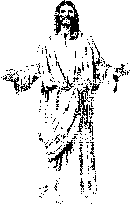 |
Jesus image source: --- Jesus ---
The phrase: three against two, and two against three can be viewed as a representation of the enumerated hemispheric attributes as are displayed in the above brain image. In other words, the phrase is describing conflicts between the left hemisphere "3" and the right hemisphere "2," just as the following image does:
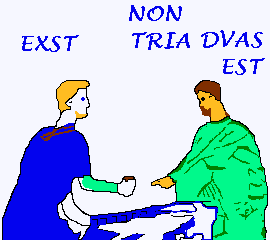 |
Roman dicers from a fresco at Pompeii,
playing what is thought to be an early version of backgammon. The cartoon
like captions above their heads describe a disputed call: the man on the
left cries, "I've won!" while the one on the right objects, claiming,
"It's not a three, it's a two." Analogously, the two characters can be viewed as the right & left hemispheres of the brain. The right adamantly refuses to acknowledge the left's claim to a 3 and insists that the "3" the left sees is actually a 2. If the overall purpose of the "game" (life) is to achieve a "3" and yet there is a claim from some for a preponderance of "2" (with all its various guises), do we try to change the rules of the "game" or create a teaching methodology which enables the distinctions of "2" and "3" to be made identifiable and useful from all vantage points? (Even if the purpose of the game is defined by Earth-specific environmental circumstances.) The social problems created by an underlying 2 versus 3 contention has been going on for long enough... since Pompeii anyway. Let's not leave a similar picture of us for future historians who find it beneath the rubble of an extinct civilization. |
Some readers may be interested in the following related link:
Previous page Update: Thursday, 22nd-March-2018... 7:31 AM
Latest Update: Tuesday, 14th Jan 2020... 8:10 AM
Herb O. Buckland
herbobuckland@hotmail.com